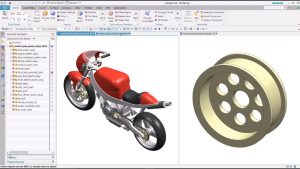
Introduction
DS CATIA (Computer-Aided Three-Dimensional Interactive Application) is a powerful software suite developed by Dassault Systèmes primarily used for CAD (Computer-Aided Design), CAM (Computer-Aided Manufacturing), CAE (Computer-Aided Engineering), and PLM (Product Lifecycle Management). CATIA P3, specifically, refers to the latest generation of CATIA software, offering advanced capabilities and enhancements over previous versions.
Key Features of DS CATIA P3:
- Modeling Capabilities:
- Part Design: Allows creation of 3D solid models of parts, utilizing features like extrusion, revolve, sweep, and more.
- Assembly Design: Facilitates the assembly of multiple parts into complex structures, with tools for managing relationships and constraints between components.
- Surface Design:
- Enables creation and modification of complex surface models, crucial for industries like automotive and aerospace where aerodynamics and aesthetics are critical.
- Sheet Metal Design:
- Specifically tailored for designing sheet metal components, providing tools for unfolding, bending, and modeling sheet metal parts.
- Digital Mock-Up (DMU):
- Allows virtual assembly and visualization of products, aiding in checking interferences, clearances, and overall assembly validation.
- Kinematics Simulation:
- Provides tools for simulating the motion of mechanical assemblies, essential for analyzing mechanisms and ensuring proper functionality.
- Generative Shape Design:
- Focuses on advanced surface modeling techniques, useful for creating complex freeform shapes and organic designs.
- Visualization and Rendering:
- Includes tools for high-quality rendering and visualization, helping users create realistic images and animations of their designs.
- Analysis and Simulation:
- Integrates finite element analysis (FEA) and other simulation capabilities to validate designs for structural integrity and performance.
- Product Data Management:
- Integrates with PLM systems for managing product data throughout its lifecycle, ensuring version control, collaboration, and traceability.
- Industry-Specific Solutions:
- CATIA offers specialized solutions tailored to industries such as automotive, aerospace, shipbuilding, and consumer goods, catering to specific design and engineering requirements.
System Requirements:
CATIA P3 for Windows typically requires a robust hardware setup due to its extensive capabilities:
- Operating System: Compatible with recent versions of Windows (e.g., Windows 10).
- Processor: Multi-core Intel or AMD processor with 64-bit support.
- RAM: Minimum 8 GB RAM, recommended 16 GB or higher for optimal performance.
- Graphics Card: Certified OpenGL graphics card with dedicated memory, supporting hardware-accelerated rendering.
Conclusion:
DS CATIA P3 for Windows is an industry-leading CAD/CAM/CAE software suite known for its comprehensive toolset, advanced capabilities in design and simulation, and integration with PLM systems. It is widely used in industries requiring complex product design and engineering, offering a powerful platform for innovation and collaboration throughout the product development lifecycle.
Details
__
__
July 14, 2024
Paid
No ads
Windows
Multilanguage
709
__
__
Download








